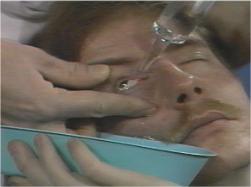|
|
|||||
Irrigate an EyeEyes normally clean themselves. But eye irrigation may be needed when the eyes are contaminated with:
Ideally, sterile saline solution is used. However, if the need is urgent and no sterile saline is available, use the cleanest water you can easily find. For example, in a field environment, if you encounter a chemical burn, the best way to prevent further injury might be to use the water from your canteen. In this case, speed in irrigation of the eye is more important than trying to find sterile saline. Tilt the casualty's head to one side and drip the saline into the corner of the eye:
Watch a video showing this technique.
This section was developed from "Eye Irrigation" A1701-78-0117V, Health Sciences Media Division, US Army Medical Department C&S, Fort Sam Houston, Texas Home · Military Medicine · Sick Call · Basic Exams · Medical Procedures · Lab and X-ray · The Pharmacy · The Library · Equipment · Patient Transport · Medical Force Protection · Operational Safety · Operational Settings · Special Operations · Humanitarian Missions · Instructions/Orders · Other Agencies · Video Gallery · Forms · Web Links · Acknowledgements · Help · Feedback Approved for public release; Distribution is unlimited.
*This web version is provided by The Brookside Associates, LLC. It contains original contents from the official US Navy NAVMED P-5139, but has been reformatted for web access and includes advertising and links that were not present in the original version. The medical information presented was reviewed and felt to be accurate in 2001. Medical knowledge and practice methods may have changed since that time. Some links may no longer be active. This web version has not been approved by the Department of the Navy or the Department of Defense. The presence of any advertising on these pages does not constitute an endorsement of that product or service by either the US Department of Defense or the Brookside Associates. The Brookside Associates is a private organization, not affiliated with the United States Department of Defense.
© 2015, Brookside Associates, LLC. All rights reserved |
|
||||


